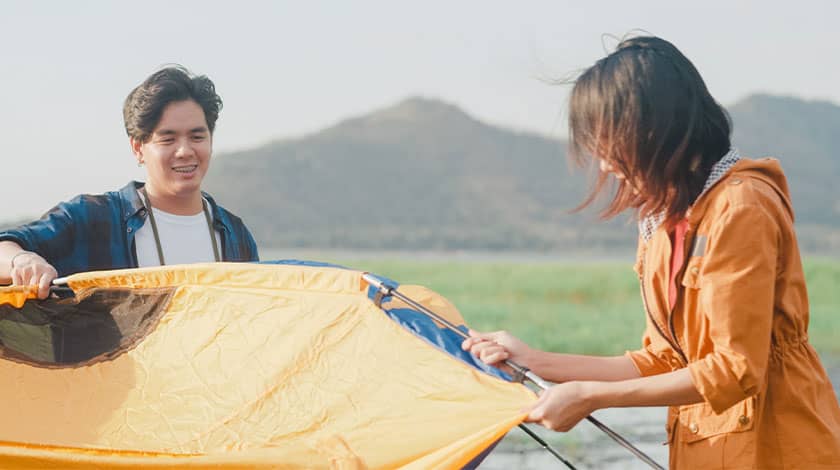How to Move and Store Your Camping and Outdoor Gear

Camping and outdoor activities are a great way to connect with nature and enjoy some quality time with friends and family. When it's time to pack up your gear and store it away or move it to a new location, proper organization and care are essential.
In this blog, we will guide you through the process of moving and storing your camping and outdoor equipment, elaborating on the importance of each point, common mistakes, and best practices.
#1 Sorting and Decluttering
Sorting and decluttering your camping and outdoor gear is crucial for a smooth move and storage process. It helps you identify what you need, what you can sell or donate, and what needs repair or replacement. This step can also help you save time, money, and space in the long run.
Common Mistakes
-
Rushing through the process of packing everything without organizing or taking sufficient time to sort and declutter.
How to Do It Properly
-
Lay out all your camping and outdoor gear in one area.
-
Sort items into categories (e.g., tents, sleeping bags, cooking equipment).
-
Check each item's condition and functionality.
-
Decide on which items to keep, repair, sell, or donate.
#2 Cleaning and Drying
Cleaning and drying your gear before storing it ensures the equipment's longevity and prevents mildew, mold, and unpleasant odors.
Common Mistakes
-
Storing dirty or wet items, leading to damage and deterioration.
-
Using harsh chemicals or improper cleaning techniques that can harm the gear.
How to Do It Properly
-
Clean all items according to the manufacturer's instructions.
-
Allow everything to air dry completely before packing.
#3 Packing and Protecting
Proper packing and protection of your gear help prevent damage during the move and ensure your equipment is ready for use when you need it.
Common Mistakes
-
Using inappropriate packing materials or containers.
-
Overpacking or under packing boxes, leading to damage or instability.
How to Do It Properly
-
Use sturdy, high-quality packing materials and containers.
-
Pack items in a way that minimizes empty spaces and prevents shifting during transport.
-
Label each box with its contents and any necessary handling instructions.
#4 Choosing the Right Transportation Method
Selecting the appropriate transportation method for your gear ensures it arrives safely and undamaged at your new location or storage facility.
Common Mistakes
-
Choosing the wrong-sized moving truck or vehicle.
-
Not considering alternative transportation options (e.g., train, courier).
How to Do It Properly
-
Assess the size and quantity of your gear to determine the right moving truck size or alternative transportation method.
-
Research and compare transportation modes with their charges for shifting to select the best option for your needs.
#5 Storing Your Gear
Storing your camping and outdoor gear in a safe and organized manner helps maintain its condition and ensures it's ready for use when you need it.
Common Mistakes
-
Storing gear in damp or poorly ventilated spaces.
-
Storing items without proper protection or organization.
How to Do It Properly
-
Choose a dry, well-ventilated, and secure storage space, such as a dedicated closet, garage, or storage unit.
-
Store items in labeled containers or on shelving units, grouping similar items together for easy access.
-
Regularly inspect your gear for damage or signs of wear, and perform necessary maintenance.
#6 Planning for Your Next Adventure
Having a well-organized and easily accessible inventory of your camping and outdoor gear makes it easier to plan and prepare for your next adventure.
Common Mistakes
-
Not keeping track of your gear inventory.
-
Failing to maintain or replace damaged or worn-out equipment.
How to Do It Properly
-
Create a checklist or inventory of your gear, so you know what you have and what you might need for your next trip.
-
Keep track of any items that need maintenance or replacement, and address these issues in a timely manner.
-
Explore new destinations and activities to enjoy with your gear.
#7 Utilizing Protective Covers and Cases
Using protective covers and cases for your camping and outdoor gear helps prolong its life and prevents damage during storage and transportation.
Common Mistakes
-
Storing items without protective covers or cases, leading to unnecessary wear and damage.
-
Using ill-fitting or low-quality covers and cases that don't provide adequate protection.
How to Do It Properly
-
Invest in high-quality, durable covers and cases designed specifically for your gear, such as waterproof cases for electronics, padded bags for cookware, or protective covers for tents and sleeping bags.
-
Ensure each item is properly enclosed in its cover or case before storing or transporting it.
#8 Storing Food and Cooking Supplies
Proper storage of food and cooking supplies ensures your camping and outdoor gear remains clean and sanitary while preventing pests from accessing your food items.
Common Mistakes
-
Storing food items in unsealed containers or bags, attracting pests and causing spoilage.
-
Mixing food and cooking supplies with other camping gear, leading to cross-contamination or damage.
How to Do It Properly
-
Store food items in airtight containers or resealable bags, ensuring they are properly sealed before storing them with your camping and outdoor gear.
-
Keep cooking supplies clean and organized, storing them separately from other gear or using designated containers or bags to prevent contamination.
-
Regularly check stored food items for spoilage or pest infestation, and replace as necessary.
#9 Storing Clothing and Footwear
Proper storage of clothing and footwear ensures they remain in good condition and are ready for use when needed.
Common Mistakes
-
Storing damp or dirty clothing and footwear, leading to mold, mildew, or unpleasant odors.
-
Not using appropriate storage solutions, such as garment bags or shoe organizers, which can result in damage or disorganization.
How to Do It Properly
-
Ensure all clothing and footwear items are clean and completely dry before storing them.
-
Use garment bags, shoe organizers, or other appropriate storage solutions to keep clothing and footwear organized and protected from damage.
-
Regularly inspect stored clothing and footwear for signs of wear or damage, and repair or replace as needed.
Conclusion
Properly moving and storing your camping and outdoor gear is essential for maintaining its quality, organization, and overall longevity. By following the steps and tips outlined in this article, you can ensure that your gear remains in excellent condition, making it easier to plan and prepare for future adventures. Remember to carefully pack and transport your equipment, select an appropriate storage space, and regularly maintain and inspect your gear. By doing so, you'll be well-equipped for countless camping trips and outdoor experiences, allowing you to fully enjoy the beauty and excitement of the great outdoors.











